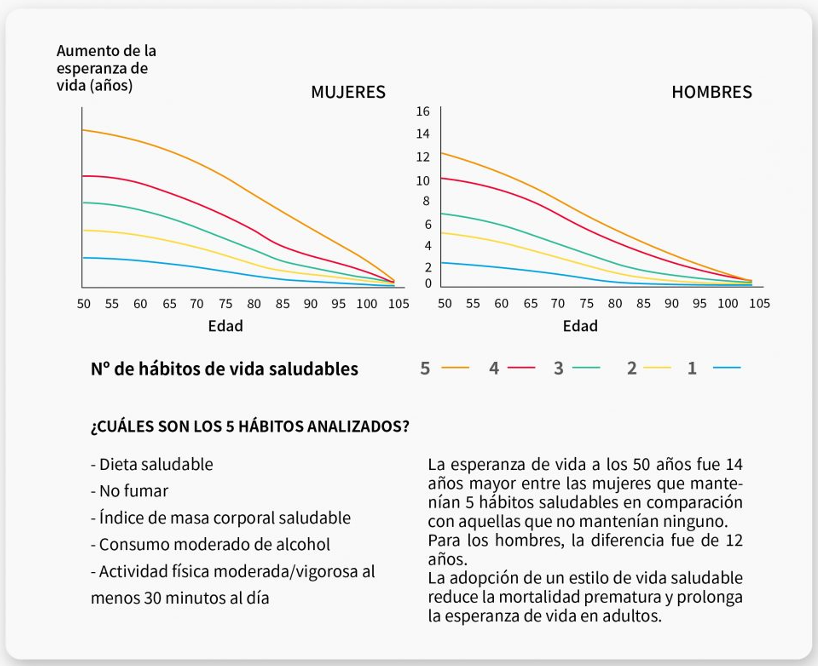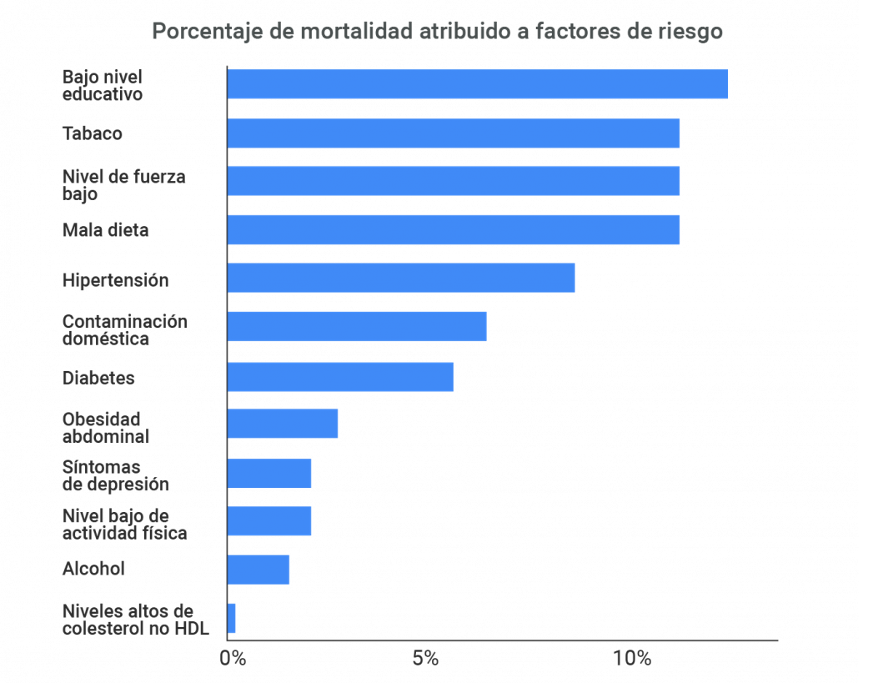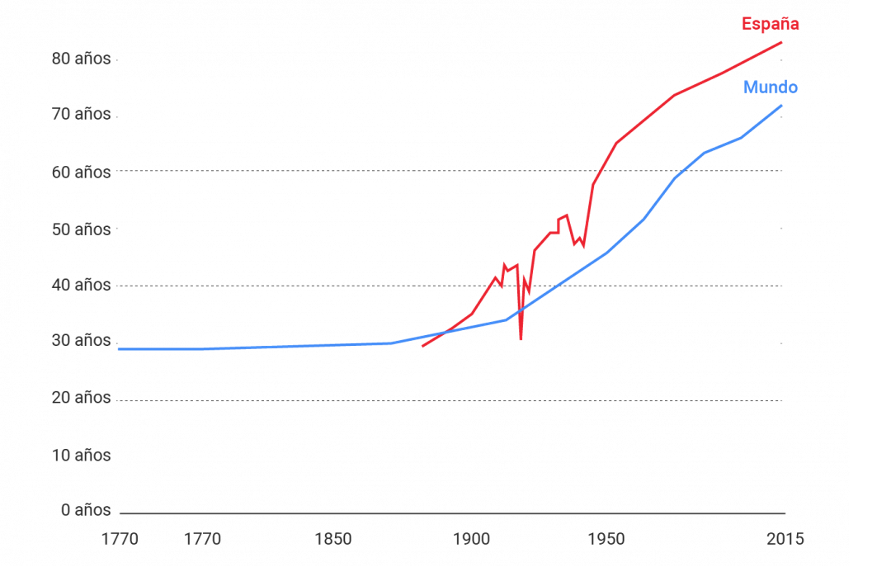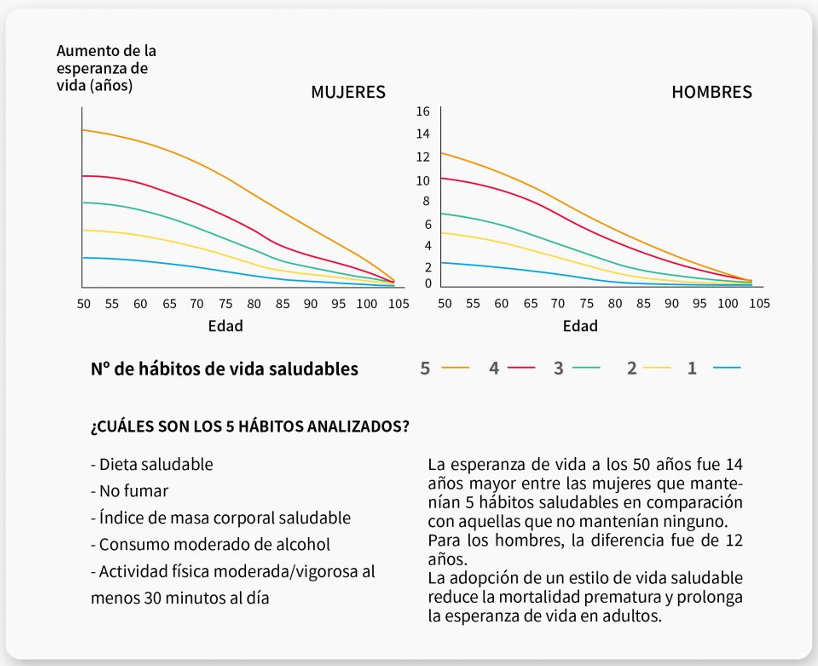Exercises and training aimed at gaining muscle strength are more beneficial when it comes to combating aging, morbidity, and mortality.
Muscle strength has been defined as one of the main markers of health. Several studies have shown a devastating link between lack of strength and a worse aging process: higher levels of muscle strength make you live longer and better.
Dr. César Montiel – Neolife Medical Team
The evidence
A study published in the journal Circulation (1) analyzed over 123,000 people and followed them for an average of 34 years in order to quantify to what extent lifestyle habits in the U.S. population could strongly affect their health. The results showed that 5 lifestyle factors (no smoking, healthy weight, regular physical activity, healthy diet, and drinking alcohol in moderation) could prolong life expectancy at age 50 by 14 years for women and 12 years for men compared to those who did not adopt any healthy lifestyle habits.
For example, in the case of women who followed the 5 healthy lifestyle factors, the projected life expectancy at age 50 was an additional 43 years, i.e., to 93, while for those who did not adopt any of them it was 29 years, to 79. In the case of men with a healthy lifestyle, it was estimated that at age 50 they would live 37 years longer (up to age 87), compared to 25 years (up to age 75) for those who do not have a healthy lifestyle.
The COVID-19 pandemic led many countries to adopt a measure that many of us associated only with wartime: confinement. The reality check faced by most of us who were unable to leave our homes for almost 3 months, it was at this time was that our physical activity rates suddenly dropped dramatically. We went from being able to walk, run, and exercise freely to not being able to do so. This lack of movement made us realize that we had lost something that is part of the essence of being human: we are what we are because we move. The result was that even those who were not so active before the pandemic had a compelling need to move.
In short, a sedentary lifestyle currently increases the risk of suffering up to 35 chronic diseases. Encouraging movement therefore, in addition to a healthy diet and a drastic reduction in smoking and alcohol consumption can help the population live longer, healthier lives.

Figure 1. Maintaining healthy lifestyle habits can extend life by more than 10 years. Li, Y., et al. Circulation,2018
What we can do
Another epidemiological study published in 2019 by one of the most prestigious medical journals, The Lancet (2), quantified the link between several risk factors and mortality in over 150,000 people from 21 different countries (including high, middle and low income countries), thus representing one of the most ambitious studies to date when it comes to analyzing the impact of lifestyle, education, or pollution on global health. Most of the data we currently have are derived from a combination of studies conducted over several time periods and with different methodologies, and few of them analyze low-income countries.

Figure 1. Link between risk factors and mortality (2). Yusuf,S., et al. The Lancet, 2020
The results showed that 75% of the cases of death were attributed to modifiable risk factors. Globally, the first factor is having a low level of education, the second is smoking, and the third is having low levels of strength (as measured by a manual grip test) (Figure 1). In other words, having a low level of strength is the third leading cause of mortality globally. The researchers quantified that those who are less strong have twice the risk of mortality than those with high levels of strength. For every 5 kg less hand strength, the risk of mortality increases by 16% (2).
These results are in line with a review with meta-analysis (3) that studied nearly two million people and found that having higher levels of strength was associated with a 40% reduction in mortality risk in women and a 31% reduction in men (Figure 2).
If we analyze the data obtained from the Lancet study and many others that are published every day, we can see how lifestyle habits determine an individual’s health condition. Although it is quite obvious, it seems that studies are needed to certify something that is logical and common sense, i.e., if you move more, if you eat less and better, if you don’t smoke and don’t drink alcohol, your health improves.
In Spain, we have gone from having a life expectancy of 42 years in 1921 to 82 in 2015 (4, 5) (Figure 3). The population is aging and, as it ages, its strength and muscle mass decreases. This is inherent to the natural aging process, but the rate at which it does so may be slowed. In this regard, physical exercise, especially strength training, can prevent functional deterioration even in older people, attenuating the loss of muscle mass (4).

Figure 3. Evolution of life expectancy in Spain and the world.
In light of the compelling data presented here, it is necessary to implement measures aimed at stopping as soon as possible a problem that is on the rise: sedentary lifestyles and their link to the development of chronic diseases.
Of all the modifiable factors shown in all these studies, but especially in the Lancet study, most diseases may be prevented through policies that encourage higher levels of physical activity and a healthy diet. In the particular case of strength, the evidence is overwhelming. Having higher levels of muscle strength makes you live longer and better.
BIBLIOGRAPHY
(1) Yanping L, An P, D. WD, Xiaoran L, Klodian D, H. FO, et al. Impact of Healthy Lifestyle Factors on Life Expectancies in the US Population. Circulation. 2018 Jul 24;138(4):345–55.
(2) Yusuf S, Joseph P, Rangarajan S, Islam S, Mente A, Hystad P, et al. Modifiable risk factors, cardiovascular disease, and mortality in 155 722 individuals from 21 high-income, middle-income, and low-income countries (PURE): a prospective cohort study. Lancet 2020 Mar 7;395(10226):795–808.
(3) Leong DP, Teo KK, Rangarajan S, Lopez-Jaramillo P, Avezum Jr A, Orlandini A, et al. Prognostic value of grip strength: findings from the Prospective Urban Rural Epidemiology (PURE) study. Lancet. 2015 Jul 18;386(9990):266–73.
(4) García-Hermoso A, Cavero-Redondo I, Ramírez-Vélez R, Ruiz JR, Ortega FB, Lee D-C, et al. Muscular Strength as a Predictor of All-Cause Mortality in an Apparently Healthy Population: A Systematic Review and Meta-Analysis of Data From Approximately 2 Million Men and Women. Arch Phys Med Rehabil. 2018;99(10):2100-2113.e5.
(5) Valenzuela PL, Castillo-García A, Morales JS, Izquierdo M, Serra-Rexach JA, Santos-Lozano A, et al. Physical Exercise in the Oldest Old. Comprehensive Physiology. 2019. p. 1281–304.
(6) Hoffmann C, Weigert C. Skeletal Muscle as an Endocrine Organ: The Role of Myokines in Exercise Adaptations. Cold Spring Harb Perspect Med. 2017 Nov;7(11).

